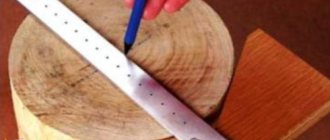Design and purpose of a nail puller
There is no person who can perfectly drive nails into any surface without making a single mistake. The percentage of errors made, of course, depends on the experience of the worker, but never drops to zero. Therefore, you can’t do without a nail puller on a construction site. In addition, quite often it is required not during the construction process, but to carry out the destruction of, for example, a wooden building. Many people burn the remains of a rotten building and use the ash, but construction nails in it will ruin all the properties, so they are removed first.
It is not always easy to remove a nail with small pliers, especially if the material is quite strong and the nail is long. This is where school physics and the law of leverage come to the rescue. Even the most stubborn nail can be reached without much effort if you have a long lever with a firm grip on the end. From here it is easy to guess about the design of the nail puller, which is quite simple. A correctly pointed end of the gripper will help pry up even the most deeply driven nail.
In general, our tool looks something like this: a long handle, at the end of which there is a bend, ending in a flattened forked tip with a slot . The length of the tool depends on the severity of the tasks that it can perform; this is the same length of the lever, which is directly related to the effort expended to pull out the nail. The pointed end easily fits under the nail head, which may not even protrude above the surface of the material. The slot firmly grips the head, and the bend as a stop allows you to smoothly move the center of gravity of the tool slightly back so that the pointed end rises, dragging the nail along with it.
Thus, without unnecessary sudden movements and enormous efforts, you will get any unsuccessful or unwanted fasteners. We have already said that most often we can find a nail puller as an additional head on a hammer. For most household work, this is quite sufficient and convenient; it can be removed immediately at the moment of hammering a nail. The hammer handle is long enough for leverage. But for more serious work, loaders and carpenters always have individual tools, made from high-strength materials. A nail puller is often used for more than just pulling nails, especially if it is highly durable.
Nail puller device
This installation tool can have different shapes, but the working part is always the same - it is a flat wedge that resembles a spatula with a forked tip. The longitudinal slot has a specially designed groove that allows you to grip the head of a nail or screw.
In addition, the nail puller will act as a lever to align fasteners. The material from which the device is made is carbon steel. A distinctive feature of the product is its high level of hardness.
Cheaper options consist of weak alloys, but they are not suitable for dismantling. To distinguish a high-quality option from a cheap one, run the tip of the nail along the working part. High-quality material should not be scratched.
Titanium nail puller – how to buy a good tool?
Looking at the design, it seems that choosing such a tool is as easy as pie. But if you are an experienced master, then you will be very demanding in your approach to the matter. In addition, the range of seemingly monotonous devices is quite wide. For example, just by length you can expect to find a purchase from 32 cm to 1 m, weight can reach as much as 4 kg, although the lightest options will only pull 0.5 kg. The material used for manufacturing also differs; most often, it is high-carbon steel, but titanium nail puller is considered the leader in strength.
Claw crowbar - the best carpentry and joinery tools for home use
A crowbar nail puller is a convenient device for removing nails from various structures. It makes it much easier for the technician to carry out dismantling work. Helps resolve the issue of removing nails quickly and efficiently. In turn, this is an ergonomic tool, despite the fact that it belongs to the category of a manual device, there are also models of an electric nail puller
If you pay attention to the photo of a nail puller, you can understand that this tool is a curved wedge with a forked end, with the help of which the head of the nail or other element being removed is captured. It is made exclusively from high quality metal and has a long shoulder.
Scope of application
Despite the simple design, the use of the tool is necessary in the construction industry.
It is used wherever the task is to remove objects from different surfaces, and it also greatly helps loaders lift heavy loads. It is used by carpenters, mechanics, and builders to solve everyday problems.
Also, the nail puller can be used not for its intended purpose, but for the reconstruction of a room, dismantling unnecessary structures and frames.
Varieties
In the classic version, the tool has the form of a rod made of steel with cut ends, and they can be on both sides of the nail puller.
The length of the standard device is from four hundred to five hundred millimeters, the diameter is from ten to twenty-five millimeters. If the length of the product increases, then the strength also increases due to the thickness, although the weight increases.
One type of tool is a hammer with a nail puller function. It has a short handle, making it mobile to use. This is a very versatile type of device, since the claw hammer can not only remove elements, but also hammer.
It has a design consisting of two different ends. On one working surface there is a round hammer head, and on the other a classic pointed part with a forked wedge.
The main part of the models has a non-slip rubberized handle. The only drawback is that the lever use of this device is limited.
The nail puller mount has gained particular popularity in the sales market among consumers. Its design has a second wedge that resembles a flat blade.
With its help, you can dismantle wooden floors, lift construction devices, and reconstruct boards. At the same time, the other end perfectly performs the function of pulling out nails and other unnecessary elements.
Recommendations
To purchase the best nail puller, you need to determine what kind of work you need the tool for. In any case, before purchasing, pay attention to the following properties of the device:
First, the crowbar should be made of a high-strength metal, such as tool steel, that is not prone to warping. Although the best quality tools are made from titanium. Of course, they are significantly overpriced.
It is desirable that the tip be coated with a special protective paint or anti-corrosion coating. This will make it as strong and durable as possible.
Secondly, the length of the tool matters. Give preference to those models that will be necessary for your work. So, to dismantle bulky structures, a device with a handle up to one and a half meters is required, and if minor dismantling work is necessary, a short nail puller up to fifty centimeters long can be useful.
The force of its impact on the material will depend on the weight of the tool. A heavy, reinforced nail puller can destroy large structures, but the work will be tedious.
Making a fixture
Instead of buying one, you can make a nail puller with your own hands. Let's take a step-by-step look at how to make the tool yourself:
- 1 step. First, select the steel wire of the required size depending on the diameter of the nails that need to be removed.
- Step 2. Next, process the tip of one part, use a hammer to flatten it, then cut a slot for further removal of elements.
- Step 3. If any defects or nicks have formed, remove them with a needle file.
- Step 4 The next step is to bend both ends of the nozzle. Start with the thicker part of the tool.
- Step 5 If possible, it is recommended to harden the device. Polish the product and attach it to the handle.
So, without much difficulty, you can independently make such a necessary thing as a nail crowbar.
Photo crowbar nail puller
How to make a nail puller with your own hands - step-by-step diagram
Step 1: Preparing the nozzle
To do this, you will need steel wires of different diameters; for the smallest nails 0.5 mm is enough, but for heavy work you can even take reinforcement. The tip should be treated first. To do this, flatten the end with a hammer on an anvil (for reinforcement, you should not flatten it, you just have to cut the material to the desired sharpness, you can do it on an emery wheel). Next, use a regular hacksaw to cut a slot of moderate depth. Too long will force us to drive the nail deep into it, and this is not at all necessary, extra work.
Tools
To drive a nail, no special experience is required; every developer can cope with this task; it’s another matter to correctly pull out a driven nail.
If the cap is flush with the surface, then it is recommended to know some of the subtleties of this work. And a lot depends when pulling out nails on what tool you choose. It is best to use a titanium nail puller for this purpose, which will handle nails best. Content:
Purpose of the nail puller
There were times when wooden nails were widely used; to do this, they first drilled holes in the boards that were suitable in diameter, and after that they connected the structural parts in a similar simple way. Such nails were called dowels. However, the dowel could not be pulled out. And today these products have been replaced with metal fasteners that have wide heads. When making wood products, there is often a need to pull out incorrectly driven nails.
They are easy to pick up with a puller - a special tool with a flattened end, where there is a wedge-shaped slot, which is convenient for gripping a nail. After hooking, you also need to pull out the fasteners, which are tightly compressed by wood fibers or wedged in a concrete panel, so you should use a forged nail puller. Leverage helps, so all nail pullers are made quite long, and near the hook there is a bend that acts as a support. The material is also of great importance, so tools for pulling out nails are often made red-hot.
Claw hammers perform the functions of an ordinary carpenter's hammer or act as a nail puller. Such a tool will help both hammer in a nail and easily remove an unnecessary one if it is installed incorrectly. Today you can find similar hammers with different handles: wooden, metal, rubberized, fiberglass.
Thus, the purpose of a manual nail puller is to pull out nails. And the area of its use is quite large. With its help, you can carefully and easily pull a nail out of the floor or baseboard. Regardless of the description of the nail puller, it is used when dismantling various buildings, wooden structures, boxes and containers. The nail puller is an indispensable tool for movers, carpenters, other technical workers and private developers at home.
In addition to the main function that a nail puller performs, its other functions are known: pulling out nails using a flattened end with a slot, breaking asphalt, ice and frozen soil, lifting various objects, opening boxes and other surfaces fastened with nails using a pointed end. The solid profile with which the nail puller is equipped successfully allows you to dismantle building materials.
Nail puller design
A nail puller is a manual lever-wedge device for pulling out nails driven into a material. The nail puller is available as a stand-alone tool or as a tool that is combined with tools such as a crowbar or a hammer, as in the photo of nail pullers.
A nail puller is a curved metal wedge, which is divided in two by a working groove, which is intended for the process of capturing and holding during the procedure of pulling the nail out of the material by the “head”. The action of a nail puller is based on the action of a wedge on the surface - the fastener and the material into which the fastener is hammered, and on the principle of leverage when pulling out the nail. Man has been using the principle of leverage since ancient times, when it was necessary to break off a piece of stone or lift a heavy object, which required remarkable effort.
This construction tool at one end has a curved flattened platform with a slot that expands, and at the other there is a straight, pointed stake. The second end is often simply flattened and sharpened. Depending on the requirements for the tool, the nail puller comes in different sizes. The price of nail pullers on the market also varies. The length of nail pullers ranges from 320 to 1000 millimeters, and the weight is 0.6 to 4 kilograms. The choice of the size of this construction tool depends directly on the size of the nails with which it will work.
Most hammers that come with the added feature of a nail puller come with a rubber grip that makes them feel like a glove in the palm of your hand. To increase the strength of nail pullers, high carbon steel is also heat treated, which is a common tool material. There are also nail pullers with a wood handle and an iron tip. But it is not recommended to get carried away with the variety of form factors; the main thing in a tool for extracting nails is the flat surface of the blade, which is placed under the head, and its level of strength.
Making a nail puller with your own hands
Any owner needs a good nail puller no less than a saw, hammer or axe. Therefore, it is useful to know how to make a nail puller at home. We suggest you make a set of three nail pullers that will help you remove any nails and fasteners.
A nail puller for pulling out small nails is best made of steel with a high carbon content so that its working part can be hardened. To do this, take a steel wire 0.5 millimeters thick, then straighten it on an anvil and flatten the working end a little.
Make a shallow cut with a hacksaw along the axis, and file the edges of the cut with a needle file. Bend the working part of the tool in a vice. It is customary to bend in two steps: first in the place where the workpiece is thicker, and then closer to the working end. Remove small dents caused by the vice with a file. Then sand the working part of the tool and, if possible, polish it with polishing paste.
It remains to complete the hardening with future tempering. After this manipulation, grind the working part of the tool again and polish it. Place the resulting workpiece on the handle. Your DIY nail puller for small nails is ready! Nail pullers for large and medium nails are usually made of reinforcing steel. Just remember that the working part does not need to be flattened. Pre-carry out all rough processing on an emery wheel.
We process metal, hardening
Before we find out what can be done on the farm using the simple set described above, let’s understand some of the properties of the metal.
Various rolled products, fittings, parts from mechanisms, that is, almost any steel accessible to the average person, becomes pliable and ductile when heated strongly. It can be flattened, bent and twisted in any way you like.
However, after the metal has cooled, it often becomes more ductile than it was before, but less hard and durable. This is especially noticeable when you work with springy steels, for example, a car spring.
The reason is the slow cooling of the workpiece during operation, during which the so-called “tempering” occurs. To restore the metal's hardness and strength again, it must be hardened, i.e. reheat and cool quickly.
Heating, tempering and hardening are the main operations in the manufacture of knives, various staples, nails and similar products requiring hardness and strength.
Useful nail options
- Illumination of the working area - a light source is built in next to the nailer head. Usually this is an LED light bulb. Thanks to the backlight, the master can conveniently work with a nail gun in hard-to-reach places where there is little lighting.
- Keyless removal of bent nails - in a batch of fasteners that are in a holder, there may well be defective bent specimens. These nails will usually get stuck in the chuck. The keyless removal feature allows you to quickly and easily remove damaged nails from the head.
- No-dry protection - The nailer will not consume any power if there are no nails left in the magazine.
- Protection from being shot into the air - this type of protection is found in almost every nail gun. To prevent the nail from flying into the air, the head of the nailers is equipped with a pressure guard. To drive a nail, you need to press the head against the surface to be joined.
We make a tubular nail puller, why it is convenient. My opinion
This nail puller can be made in two ways, in the first case using a metal rod with a diameter of 16 mm, and in the second a ready-made pipe of the same diameter.
The first method is labor intensive
We make a hole in the rod with a 10 mm drill and accordingly we get a tube, then we cut out a corner in it with a grinder using a metal disc and grind one plane with it.
Method two
We take the finished tube, bend it, also cut out a wedge and grind it off. This method is the easiest and fastest; it allows you to make a nail puller from any pipe.
Its disadvantage is that the curved hollow pipe is less strong than a rod.
Where did the idea come from?
The fact is that I already had the tool that I described in the first version; I just corrected it a little with a drill and an angle grinder.
Presumably this is a product of the Soviet Chelyabinsk Machine-Building Plant of automobile trailers, which at that time cost 95 kopecks. I was surprised by the tubular design, which I saw for the first time; I had never seen such a design before.
Why is it convenient?
He is able to pick up the nail head as close to the surface as possible to remove it
, none of its classic counterparts will repeat this.
In the photo above, for demonstration, I used a nail to nail the trim, it practically has no head
, but the tool did an excellent job with it, like this.
To create such a product, you can choose two options: make it from a pipe or a solid rod, bending the end with a wedge to the angle you need.
Subscribe to the channel, share the publication with friends, like it, like it. Your Home Repair.
Source
What you need to make a homemade nail puller
Materials for making a nail puller with your own hands you will need:
- Old rasp. If it is not there, then you can find a replacement in the form of a piece of thick metal, at least 10-12 mm thick;
- A piece of metal strip. It is needed to make corners. You can purchase ready-made corners, for example, for a door leaf. In general, there are several options here;
- A small piece of profile pipe 20x20. The pipe will be needed to make the handle; it is on it that the entire structure of the homemade nail puller is attached;
- Long bolt with nut and washer;
- Straight arms.
When making homemade carpentry, you cannot do without welding tools, a grinder and a screwdriver with a metal drill. In general, there is nothing complicated, and after preparing all the necessary materials and tools, you can begin assembling the device.
Types of nail guns
Primarily, nailers can be classified by magazine type. Nail guns are:
- Cassette
- Drums
As is clear, in this context, nail guns differ only in the shape of the clip.
- Cassette nailers - the shape of the clip in the form of a straight rail. A cassette usually holds up to 100 nails. The drum has a large capacity. But cassette nail guns are valued for their compact size and light weight.
A nailer with a straight clip will be more convenient to work in hard-to-reach places. Among cassette nail guns, there are models that can be loaded not only with nails, but also with pins (nails without heads), and even with staples from a stapler.
What other types of nailers exist?
- Drum nailers are a cylindrical drum shape. The drum holds many more nails than a standard rack cassette. But as the capacity of the drum increases, the weight of the nail gun, as well as its overall dimensions, will also increase.
Drum-type nailers are chosen when you need to make a large number of connections without being distracted by reloading. Such nail guns are often used in conveyor assembly of structures and in production.
What else you need to know about how to choose a nail gun.
Scope of application of nailer
The scope of use of a nail gun is so vast and varied that this tool becomes truly universal . He will be welcome both in the carpentry workshop and on the construction site. A nail gun is useful in production and any repair area.
Nailers can be used in the following cases:
- Furniture assembly and repair
- Creation of wooden structures
- Manufacturing of containers and packaging of products
- Construction of houses and various buildings
- etc.
The nail gun can be used just in everyday life: hammering beads, fixing lining, assembling a rack, restoring a fence, and so on.
The very widespread use of nailers is due to the following factors:
- Compact size and light weight
- High performance
- Ultimate safety
- Precise and easy nailing
Craftsmen especially value nail guns for their ability to hammer nails with one hand. You can hold the parts of the structure to be connected with your other hand. It is very comfortable.
Next we will talk about how to choose a nail gun.
Welding blanks and assembling fixtures
At this point, the first part of making a nail puller with your own hands is completed, you can begin making the sole. For this you will need an old rasp, but you can, as mentioned above, get by with a piece of thick metal.
Cut a piece of rasp to the required length.
Cut it into two equal halves.
We sharpen one of the edges of each half on a sharpening machine or use a grinder for these purposes.
Then we weld one half to the profile pipe.
And we weld the other half to the corners.
We fix a metal roller on the back of the corners.
The principle of operation of the homemade product is to grab the head of a nail or self-tapping screw and pull it out under the force of the handle. It's simple, but very effective in practice.
This is just the beginning
Mastering the described techniques for working with metal will allow you to produce not only utilitarian objects, tools or fasteners. The same methods will allow you to create complex shaped elements. By fastening them with small forged clamps, or connecting them by welding, you will be able to assemble real forged masterpieces, which you can easily show off among your friends!
I recommend: How to cut a thread with a die or tap, incl. on pipes
Don't forget about safety.
Canvas mittens, durable shoes, and safety glasses will protect you from injury and burns. Leave your tips and comments below. Subscribe to our newsletter. Good luck to you and good luck to your family!










